‘Wyndham Station’
A motivation for long-term landscape resilience
A REGENERATIVE AGRICULTURE CASE STUDY
 Meet Angus and Kelly Whyte from Wyndham Station
Meet Angus and Kelly Whyte from Wyndham Station
Angus and Kelly Whyte were dissatisfied with the amount of work they were having to put into their property for little financial return just to watch the condition of the land deteriorate. By gaining a new perspective, a motivation for long-term landscape health now guides all decision making on Wyndham Station. As a result, vegetation cover, soil health and water-use efficiency have all improved, leading to increased carry capacity and productivity. The landscape is more resilient and the Whytes are well-equipped with the tools to help them manage the impacts of drought.
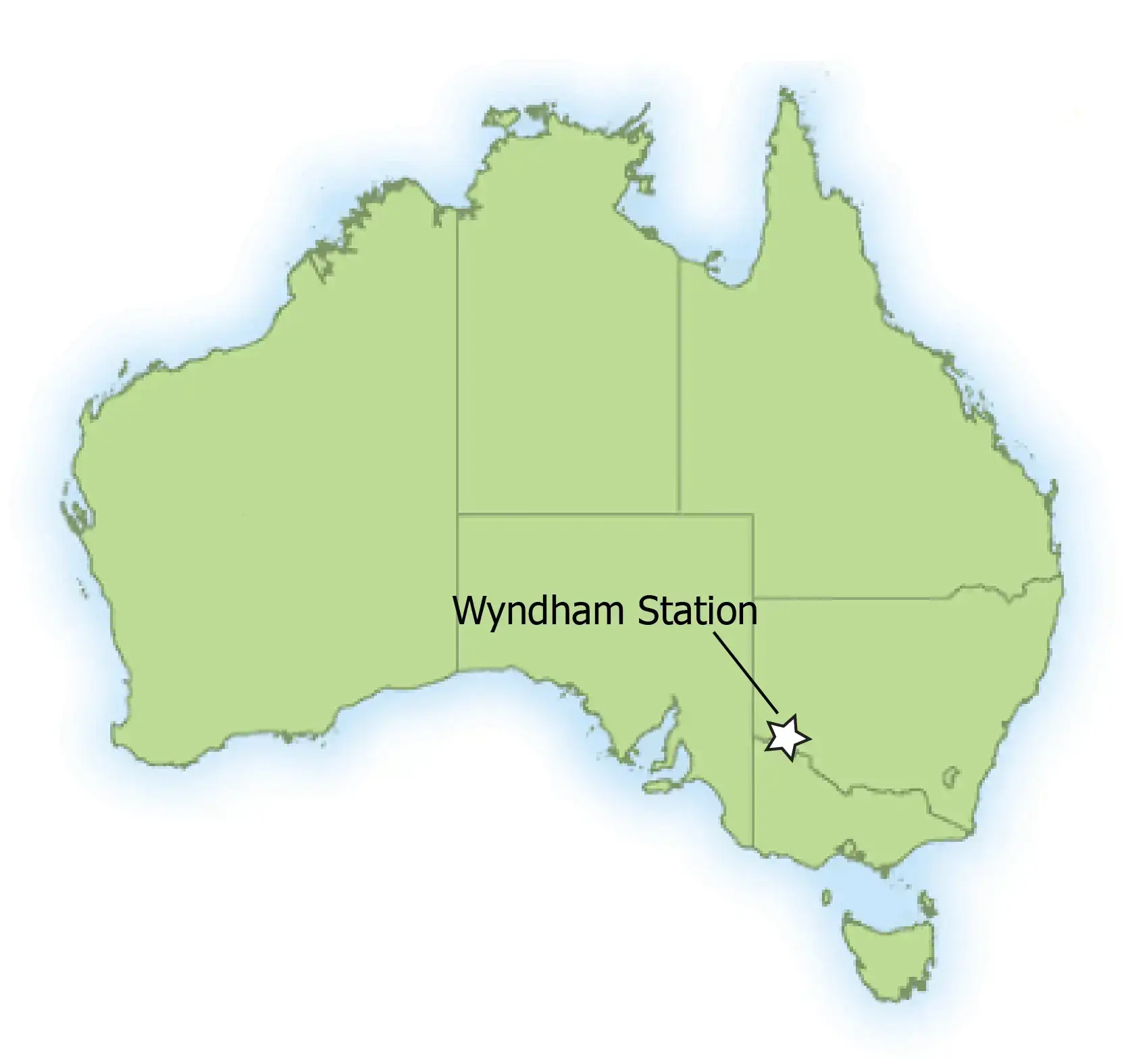
85km north of Wentworth, Lower Western NSW
ENTERPRISE: Sheep and Cattle breeding and trading, opportunity cropping
PROPERTY SIZE: 12,500 hectares
AVERAGE ANNUAL RAINFALL: 260 mm
ELEVATION: 30 m
PRACTICES COMMENCED: 2002
RESILIENCE BUILDING PRACTICES
- Making long-term landscape health and productivity the driving factor for farm management decisions.
- Implementing planned (holistic) rotational grazing management, allowing sufficient time for forage rest and recovery before re-grazing.
- Matching the stocking rate to carrying capacity by adjusting stock numbers according to monitored conditions.
- Mobbing stock to use livestock to disturb the soil surface and create germination opportunities.
KEY RESULTS
- Building a more resilient landscape and business by improving landscape ecological function.
- Increasing vegetation cover and diversity, extending the growing season and production potential and protecting the soil surface.
- Improving soil organic matter content and structure, leading to improved rainfall infiltration, retention and water-use efficiency.
- Developing increased control over stocking and income.
- Improving the property carrying capacity, enabling stocking rate to be almost doubled within 10 years, from 55 to 100 DSE days/ha/100mm rain.
- Reducing on-farm labour input by 60%.
- Increasing gross margin from $8 per hectare to $12 per hectare.
- Building a more predictable and reliable business that has reduced personal and family stress and improved family lifestyle.
Building resilience to the impacts of drought
A landscape that is most resilient to the impacts of drought is one with high proportions of continual groundcover, supporting healthy soils and effective rainfall infiltration and retention. Such a landscape supports a bio-diverse ecosystem with healthy nutrient cycles of growth, breakdown and decay.
Many years of over-utilisation of natural resources in the Western Division has resulted in significant degradation of landscape condition, leading to sparse vegetation, hard-capped soils and a cycle of continuing degradation. Combined with the extremes of climate this region is subject to, the landscape and pastoral production is regularly affected by multi-year droughts.
Innovative farmers in the region are illustrating that active and innovative landscape management can restore degraded landscapes by rebuilding the landscape’s regenerative capacity and at the same time delivering sustainable production; regardless of seasonal conditions. Rather than accept that these landscapes are vulnerable and fragile, innovative farmers are learning to work with these landscapes to actively restore landscape structure, composition and function.
Angus and Kelly Whyte, of Wyndham Station north of Wentworth, have, since 2002, changed the way they view the landscape and make on-farm decisions to invest in the long-term health and productivity of their 12,500 hectare property. They now run a successful sheep and cattle breeding and trading business and are confident that they have the tools and information to be able to manage Wyndham Station in periods of drought to ensure an ever-improving and more resilient landscape and enterprise.
The key factors influencing the resilient landscape and business being built on Wyndham Station are:
- Making the long-term health of the landscape the focus of all management decisions.
- Managing grazing to increase and maintain groundcover, particularly palatable perennial species, which also protect the soil and increase rainfall infiltration and retention.
- Monitoring their rainfall and forage availability in order to match the stocking rate to the carrying capacity.
- Practising planned rotational grazing, using large mobs of stock to disturb the hard-capped soil surface and providing sufficient rest for forage to recover before re-grazing.
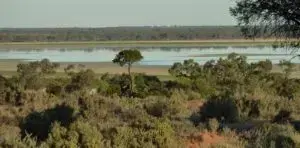
Agriculture on the semi-arid rangelands
WYNDHAM STATION
Wyndham Station comprises 12,500 hectares in the far south-western corner of New South Wales, 85km north of Wentworth, which lies at the confluence of the Murray and Darling Rivers. The Great Anabranch of the Darling River forms the eastern boundary of the property, which also includes an ephemeral lake of around 1,000 hectares.
As part of Australia’s extensive semi-arid rangelands, which cover 75% of the continent, the climate of this area is characterised by hot and persistently dry weather and erratic rainfall. The Bureau of Meteorology reports a long-term average rainfall in Wentworth of 286mm, ranging from 102mm in 1982 to 705mm in 1870.
This region of the Western Division is made up of undulating red soil plains and grey floodplain clays.
In the late 1800s and early 1900s the effects of total grazing pressure caused by high numbers of sheep and plague rabbits, were compounded by the effects of the multi-year Federation Drought. Over-utilisation of the understorey and ground layer vegetation across the region changed the condition of the native vegetation and the ecological function of much of the landscape.
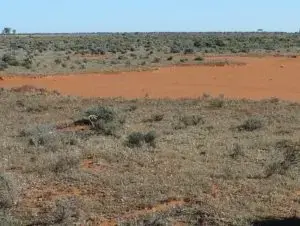
Areas of claypan – bare exposed subsoil – are characteristic of
landscape degradation in the semi-arid rangelands.
The over-grazing resulted in topsoils being exposed to erosion by water and wind. In many areas topsoils were either washed or blown away, leaving the exposed sub-surface soil, which is higher in clay content. Over time these areas became hard-capped and bare of vegetation and are now characteristic of degradation in the region. Rainfall cannot readily penetrate these hard-capped soils, instead runoff rushes over the soil surface, leading to gully erosion in some areas. Seeds do not readily germinate in such conditions, and consequently even in better rainfall years the landscape struggles to respond with the reestablishment of perennial grass groundcover or rehabilitation of shrubs.
Much of Wyndham Station is dominated by chenopod shrublands 1 comprising saltbush (Atriplex spp.), pearl bluebush (Mairena sedifolia) and black bluebush (Mairena pyramidata) with an understorey of spear grass (Austrostipa varibilis), other mainly annual grasses, copper burr (Sclerolaena spp.), common bottle-washers (Enneapogon avenaceus) and various forbs. The property also has some woodland areas, mostly dominated by belah (Casuarina cristata) and black box (Eucalyptus largiflorens).
Angus and Kelly Whyte have been on Wyndham Station since 1998. Their original property management practices were typical of those in the region. The property was conservatively stocked with Merino sheep. Management focused on animal performance and production, with little consideration for the ongoing status of the land. Paddocks were continuously set-stocked, regardless of seasonal conditions. This ultimately led to overgrazing in times of drought.
The many farm dams provided stock water and animals were given uncontrolled access, with little thought of loss through evaporation or water quality.
At this time, the family was working six to seven days a week with little financial return.
The Whytes observed that landscape productivity and health was declining across a range of factors – grass was sparse and the livestock was suffering from a carbohydrate (fibre) drought each year. The landscape and their enterprise were becoming ever more vulnerable to impacts of short-term and multi-year droughts.
It was with this dissatisfaction with income, the condition of the land and the amount of work involved in running the farm that Gus and Kelly decided to explore alternative ways of managing their property.
Changing Practices
FOCUSING ON THE LAND TO BUILD RESILIENCE
To build landscape health and the ability to regenerate regardless of climatic conditions, the landscape needs to be the focus of management decisions.
With a lot of perseverance and very little money, the Whytes set about finding a way forward to address their concerns. They learned that the land used to have a much greater carrying capacity and that there was an opportunity to rehabilitate the landscape and provide them with greater resilience in the face of drought, in both landscape condition and financial stability.
To build landscape health and the ability to regenerate regardless of climatic conditions, the landscape needs to be the focus of management decisions.
Gus and Kelly realised that the landscape could repair itself if they gave it the chance. They understood that by building a more diverse ecology over time they could achieve greater resilience in their landscape and their business. Therefore, to build landscape health and the ability to regenerate regardless of climatic conditions, the landscape needed to be the focus of their management decisions, rather than the stock. Hence the Whytes developed a philosophy to work with nature and ensure that the land consistently improved while producing a quality product.
Gus feels that the reason why they manage Wyndham Station the way that they do is more important than how (that is, the techniques they use to achieve their landscape outcomes). Accordingly, this is a driving force for the success of the Whyte’s enterprise; working and making decisions in alignment with their personal values and goals for their landscape, as well as their livestock and lifestyle.
Education and Training
Attending the Resource Consulting Services (RCS) Grazing for Profit course in 2001 was a key investment for the Whytes in changing property management practices for a greater focus on landscape health. Grazing for Profit involves holistic integrated management training for farmers, graziers and mixed farming enterprises. It focuses on the use of natural plant, animal and water cycles as an integral part of on-farm decision making, to lead to both increased profits and increased sustainability of land resources. 2
Overgrazing is a factor of time, not of stock numbers.
Planned rotational grazing (also referred to Holistic planned grazing) is a key management practice introduced through the Grazing for Profit course. This practice aims to replicate the natural behaviours of large grazing animals on the landscape – where large herds graze an area intensively for a short amount of time and then move on, not returning until pastures have fully recovered. On farm, planned rotational grazing utilises increased paddock numbers of smaller size to control stock grazing pressure.
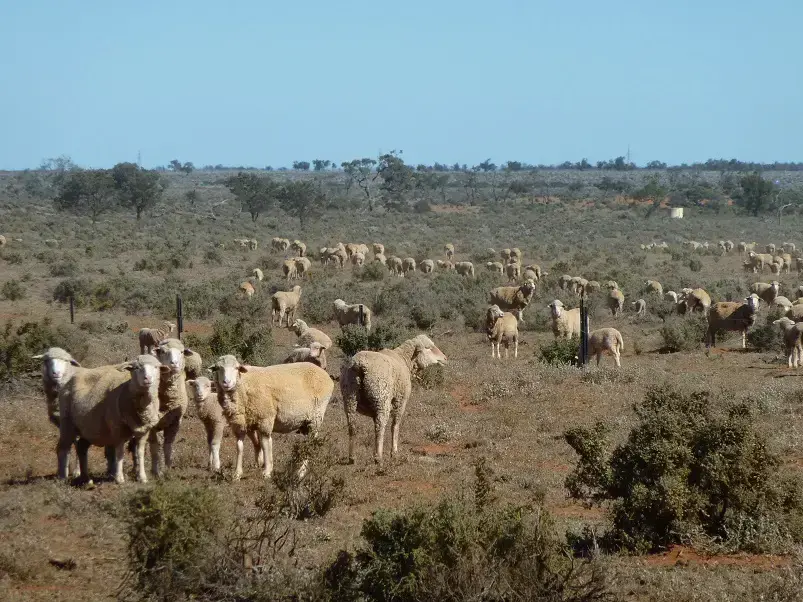
Planned rotational grazing (or Holistic planned grazing) is a technique for managing livestock that helps to regenerate the landscape.
Whilst overgrazing is usually associated with too many animals in a grazing area, holistic training demonstrates that time is the critical factor. It explains how overgrazing occurs when animals stay too long when growth is fast, for example, in fast growth periods, a plant bitten on day one can be bitten again on day three – this is overgrazing. Preferred pasture species which are selectively grazed are more vulnerable to being lost through this behaviour. Overgrazing can also occur when animals return too soon when growth is slow, meaning plants will not have fully recovered from the last grazing and will thus be overgrazed.
Planned rotational grazing management ensures that rainfall amounts, forage recovery time and feed quantity available are all considered to determine carrying capacity and grazing/rest duration and thus stocking rate and mob density.
Gus has since received support and improved his ongoing knowledge of rotational grazing through further education and training from RCS, and from service providers Principle Focus and ProAdvice. He has found that developing new skills and acquiring tools has been necessary to manage the different farming system they have adopted. All of this, including professional advice, is seen as a worthwhile investment as mistakes can be costly.
The Whytes continually build knowledge and seek further education to enable them to meet the landscape goals for their property. As part of his overall education, Gus also attends various field days and has participated in stock nutrition courses.
Follow-up through the RCS course skill development and coaching Graduate Link and Executive Link programs from 2002 to 2005 provided essential support through basic changes and development of fencing infrastructure to implement the new grazing management program that the Whytes chose to adopt.
Gus has since received support and improved his ongoing knowledge of rotational grazing through further education and training from RCS, and from service providers Principle Focus and ProAdvice. He has found that developing new skills and acquiring tools has been necessary to manage the different farming system they have adopted. All of this, including professional advice, is seen as a worthwhile investment as mistakes can be costly.
The Whytes continually build knowledge and seek further education to enable them to meet the landscape goals for their property. As part of his overall education, Gus also attends various field days and has participated in stock nutrition courses.
Infrastructure
Since 2001, paddock numbers have been increased from 8 to 34 to facilitate the planned rotational grazing. Gus is looking to further increase paddock numbers but also to make more use of stock handling skills to influence animal grazing patterns rather than just rely on fencing.
The boundary fence along either side of the Silver City Highway is 6-strand plain wire with an electric top wire. Internal fences are generally low 3-strand electric plain wire, with some single-wired fences also used.
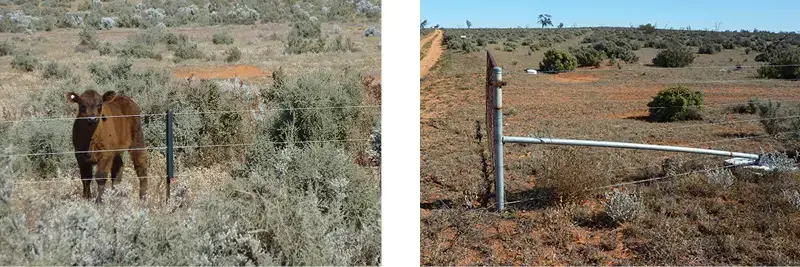
Left: Most of the internal fences on Wyndham Station are 3-strand plain solar electric.
Right: Highway fencing comprises 6-strands.
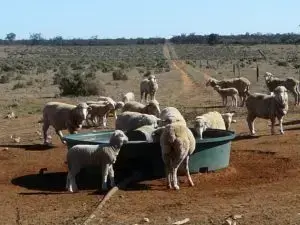
Controlled troughing maintains water quality, minimises wastage and helps reduce pests grazing on resting pastures.
More robust fencing is not required as, by using LSS methods, stock are familiarised with handling and regular rotation and are trained to observe fences as boundaries. In addition, as stock are used to regular rotation to access fresh forage, a ‘barrier’ as such is thus not required to contain stock to specific areas.
Fortunately, unlike in some other parts of the Western Division where large numbers of feral goats and kangaroos add to the total grazing pressure, there has been little impact by populations of these species on Wyndham Station and the surrounding region. This also reduces the requirement for heavier fencing to protect resting pastures.
Whilst early additions saw a path cleared for fencing, Gus later adapted fence construction processes to leave ground cover (except larger shrubs) and natural undulations to better maintain landscape health. Fencing costs average $1000 a kilometre.
To help fund infrastructure developments Gus obtained two funding grants of around $30,000 each from the local Catchment Management Authority (now Local Land Services Western Region) and under the Government’s West 2000 Plus program for infrastructure and rabbit control activities.
No longer dependent on the original farm dams, stock water is now provided via pipeline to troughs throughout the property. Water supply is via allocation from the Darling Anabranch Pipeline Scheme which began in 2006. Water from the Murray or Darling Rivers is, initially, pumped into large holding tanks prior to reticulation. Some infrastructure, tanks and troughs were provided by the Pipeline Scheme.
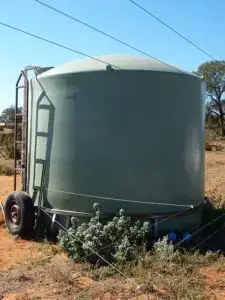
A portable tank and trough system helped to design and set-up permanent infrastructure.
Troughs are generally located at the intersection of paddocks. Troughs are seen as easy to control and provide better water quality than open dam access. Water supply is only provided to paddocks in use, reducing evaporation wastage and access by any pest animals to minimise grazing of recovering pastures.
Investment in water provision is always valuable if it is well planned and allows stock to utilise the landscape.
Gus initially used a portable 3,000 gallon tank on a frame, towing it to different locations in various paddocks. This allowed a lot of thought to be put into where to position watering points, as well as providing a temporary water point over scalds to help rehabilitate such areas. While the tank is now stationary, Gus indicates that he may use a similar technique as he increases paddock numbers.
The Whytes are planning to invest in larger capacity pipes to enable them to increase mob sizes at the farthest reaches of their property. Gus aims for stock to not have to walk more than 2km to water. He believes that investment in water provision is always valuable if it is well planned and allows stock to utilise the landscape.
Wyndham Stock
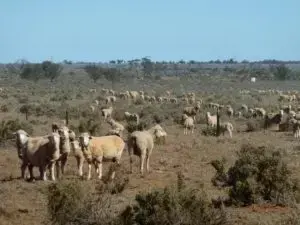
Sheep are grazed in large mobs related to prevailing landscape conditions, here, around 2000DSE in August2014.
Wyndham Station currently runs a Merino flock of around 1200 head, joined to Merino Rams for wool and meat, with the older and cull ewes joined to White Suffolk rams. The nature of the stock is very important to Wyndham Station. Gus acknowledges that the sheep may not have the finest wool or highest lambing rates, but much of their value is in their temperaments and adaptation to local feed, climate and management practices.
Autumn is generally an important time of year for stocking decisions. Lambing time is managed for June when feed conditions are likely to be best. If it is dry in April, the decision is made to sell extra ewes rather than keep them until lambing time. The other key stocking decision date is November, after weaning has been completed and stocking rate decisions can be made before it gets too hot.
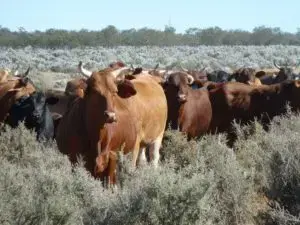
Improved landscape condition has enabled cattle to be
re-introduced onto the property.
With improving conditions, cattle were reintroduced onto the property in 2009 with an assortment of 130 heifers, mainly Santa-Droughtmaster crosses and 130 mixed-sex Murray Grey weaners. By 2012, through further purchases and as a result of a good season, they built their herd up to 500 breeders. This has been reduced back to 280 cows after poor rain seasons – maintaining and improving landscape condition is always the priority.
Understanding the landscape also means that the Whytes acknowledge that they are farming in low weight-gain country. This influences their management decisions and the Whytes see themselves as cattle breeding rather than finishing region, aiming to sell calves at a young age to fatteners or buy stock to either calve down or sell pregnancy tested in calf (PTIC).
Production
Improving and maintaining landscape condition to increase carrying capacity is a key driver of cash flow and long-term profit. To better understand the value of the farm’s key asset – forage – Gus undertook a KLR Livestock Marketing course and manages according to these principles. The KLR model provides tools to assist in measuring the full cost of production, incorporating all direct and indirect costs, informing decisions on what livestock to sell and buy to maximise profit, independent of market conditions. This enables the Whytes to better value their forage and help manage livestock numbers. The trading method used is a ‘sell-buy’ technique, meaning new stock is purchased from profits of previous sales, rather than ‘buy-sell’, which relies on the market conditions at sale time to determine whether a profit is made on previously bought stock.
During drought mob size is reduced and excess stock are sold.
During drought mob size is reduced and excess stock are sold. Stocking rates on Wyndham Station are determined with reference to forage budgets, grazing charts, monitoring site information, pasture inspection, rainfall and resultant pasture conditions.
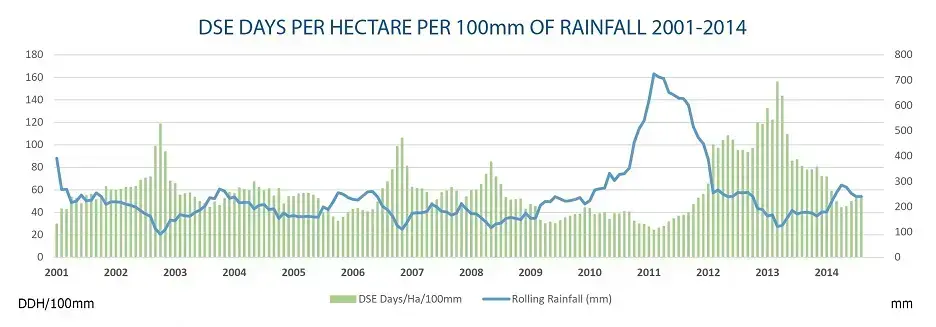
The graph illustrates the Whyte’s responsiveness to match stocking numbers to seasonal conditions. By focusing on landscape condition rather than stock numbers Gus is investing in the long-term health of the landscape – and ongoing enterprise profitability.
Opportunity cropping on the 670 arable hectares of the lake bed provides and additional income stream after a good season.
Gus has consistently achieved results over his minimum target of 30% return on this investment.
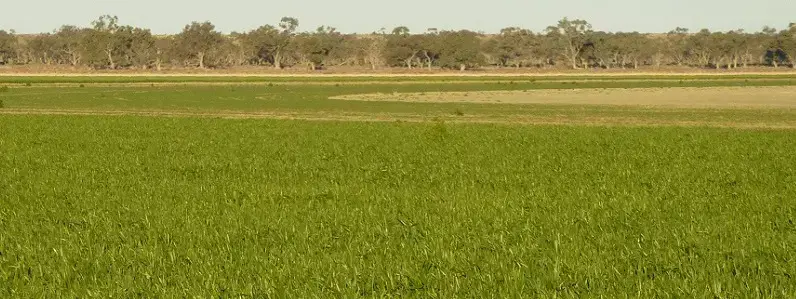
Opportunity cropping on the ephemeral lake bed provides an additional income stream in good seasons.
Monitoring and Measurement
Gus recognises the importance of regular monitoring of landscape health, though acknowledges that his personality type does not lend him to doing this religiously. He previously received assistance from the Department of Primary Industries to set up a balanced monitoring program which was followed strictly over a couple of years. Whist other commitments have impacted on routine monitoring, Gus believes the process helped him to better interpret overall landscape health during his day-to-day work on the property.
Monitoring Program Aims:
- Increase animal production from historical numbers by increasing biomass and density of palatable perennial plants, specifically perennial grasses
- Capture and retain scarce resources such as nutrients and moisture for a more stable and productive landscape
- Be simple to do.
FIXED SITE PHOTO MONITORING POINTS
A permanent marker, such as a star picket, is used to indicate where the photograph should be retaken at subsequent measurement periods. This simple photographic record clearly shows the changes in groundcover on Wyndham Station, improving over time and with significantly more growth after higher rainfall in 2011-12.




TRANSECT MONITORING
Measurements are taken from a permanent 100m transect over different land types, recording percentage ground cover, plant density measurements, species composition and soil features at 10m intervals using a 50x100cm quadrant. These measurements allow objective comparisons to be made over time.
GROUND COVER (plant & litter)
| Site No. | 2009 | 2010 | 2011 | 2012 |
|---|---|---|---|---|
| 1 | 15% | 13% | 26% | 26% |
| 2 | 18% | 17% | 26% | 47% |
| 3 | 15% | 4% | 26% | 28% |
| 4 | 19% | 5% | 35% | 25% |
PADDOCK YIELD KG/HA
(amount of dry matter per hectare that stock have eaten)
| Site No. | 2009 | 2010 | 2011 | 2012 |
|---|---|---|---|---|
| 1 | 176 | 250.1 | 421.8 | 412.5 |
| 2 | 137.5 | 165.4 | 324.9 | 484 |
| 3 | 88 | 63.1 | 93.1 | 242 |
| 4 | 74.8 | 157.5 | 78.8 | 74.8 |
AVERAGE SPECIES COUNT
| Site No. | 2009 | 2010 | 2011 | 2012 |
|---|---|---|---|---|
| 1 | 7 | 10 | 13 | 9 |
| 2 | 14 | 11 | 13 | 8 |
| 3 | 6 | 6 | 9 | 6 |
| 4 | 7 | 3 | 7 | 5 |
RAINFALL IN 12 MONTHS PRIOR TO MONITORING
| Site No. | 2009 | 2010 | 2011 | 2012 |
|---|---|---|---|---|
| 1 | 174mm | 219mm | 753mm | 436mm |
| 2 | 174mm | 219mm | 753mm | 436mm |
| 3 | 147mm | 206mm | 630mm | 346mm |
| 4 | 147mm | 206mm | 630mm | 346mm |
The monitoring data reinforces how variable the climate can be and the extremely variable volumes of vegetation that can be produced in this region. This further reiterates why it is so important to actively understand and manage feed available, as conditions can change so extensively. By having the tools to measure feed availability – Gus always knows what feed he has available for the coming six months – he is able to make informed decisions to manage in times of drought.
Summary of Costs
Investment on Wyndham Station is prioritised based on what is determined to provide the fastest return on investment balanced against the Whyte’s personal values and goals for their landscape, livestock and lifestyle. Innovations have been funded incrementally in years where surplus funds were available. Gus indicates that it has taken 10 years to fully recoup cost of his investments.
- Capital expenditure required for fencing and water upgrades totalled about $10 a hectare ($125,000) – indicative over 12 years
- Fencing costs run at about $1000 per km
- Eight additional water points have been added at a cost of $28,000
- Annual water reticulation costs $5000 in power, $1800 for water supply, minus infrastructure depreciation
Outcomes
Building a resilient landscape
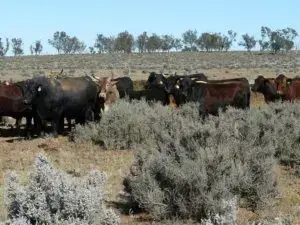
The increased carrying capacity has enabled all investment costs to be recouped, though in the more variable conditions of the Western Division, this takes longer than in heavier rainfall zones nearer the coast.
It is actively making decisions on factors within their control – stocking numbers and grazing management – with a focus on overall landscape health that has helped to build greater resilience to the impact of drought on Wyndham Station.
The Whytes noted early after changing practices that their farm was easier to run with fewer labour requirements. Small meaningful changes began to be observed in the landscape as patches of perennial grasses expanded and erosion began declining. Overall improved vegetation and soil condition was apparent within two years of starting the new grazing system.
The practices have provided a better understanding of landscape limitations through the use of such tools as grazing charts and land monitoring sites. These tools enable Gus to make good decisions so business can be resumed after drought much faster. The Whytes also have obtained increased management flexibility through providing greater opportunity to sell or buy stock. Gus’ management methods have meant that the landscape has improved following each drought, rather than degraded.
The Whytes have achieved increased landscape health through their grazing management practices. Improved vegetation cover and soil condition has improved water use efficiency, enabling carry capacity to be increased from 55 DDH/100mm to 100 DDH/100mm in 10 years. Average stocking rates in the district are 40-55 DDH/100mm.
Gus originally set a target of three times the original carrying capacity in 30 years, however, after being able to more than double the carrying capacity after 10 years (4000 DSE to 12,000 DSE), this is seen as too low a target and may need to be reassessed, to up to five or six times, depending on longer term seasonal conditions. Aware that the landscape used to be far more productive than it is currently, Gus sets a high target for landscape health and carrying capacity. However, this is a goal to influence management decisions, and it will not be considered a failure if it is not attained.
The Whytes are now averaging a current gross margin of $12 a hectare, compared to their previous margin and regional norm of around $8 a hectare.
The goals and flexibility of the grazing system used by the Whytes helps to continually achieve increased groundcover and diversity in vegetation.
The Whytes are observing improved landscape condition in terms of increase in groundcover and species diversity. There is an increase in density of palatable grasses and perennials. From just two species prior to management change, now, at least a dozen perennial grasses are commonly found on the property. These include:
| Kerosene Grass (Aristida contorta) | No.9 Wiregrass (Aristida jerichoensis) |
| Windmill Grass (Chloris truncate) | Mulka (Eragrostis dielsii) |
| Neverfail (Eragrostis setifolia) | Native Millet (Panicum decompositum) |
| Hairy Panic (Panicum effusum) | Five-Minute Grass (Tripogon loliiformis) |
| Feather Top Speargrass (Austrostipa elegantissima) | Cotton Panic (Digitaria brownie) |
| White-Top (Danthonia caespitose) | Queensland Bluegrass (Dichanthium sericeum) |
| Curly Windmill Grass (Enteropogon acicularis) | Buffel Grass (Cenchrus ciliaris) |
An active erosion gully, receiving extra moisture and nutrient runoff from the Silver City Highway, demonstrates the regeneration potential and the natural seedbank held within the soil. Gus’ grazing management practices have improved rainfall infiltration and retention, helping to reduce runoff into this and a number of similar gullies, holding the nutrients higher in the landscape and creating the conditions for this vegetation to germinate and expand.
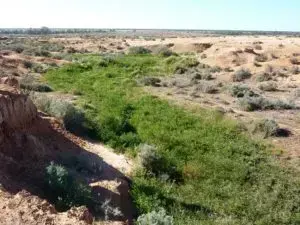
Regrowth in a healing erosion gully shows the natural seed bank in the soil, ready for a germination opportunity.
The gully is now at a stage where simple rehabilitation earthworks such as contour banks can be constructed to further improve landscape hydrology and reverse erosion. Without the improved rainfall infiltration such banks previously would have washed away.
The benefits to resilience of diverse vegetation and high levels of groundcover are numerous, including:
- Ground cover protects soil from erosion by wind and water, and from incursion by undesirable plant species.
- Vegetative cover and various root depths add soil organic matter, building soil carbon and soil water-holding ability. Consequently, rainfall better infiltrates the soil, rather than running off, as well as being retained for longer after rain, still accessible for plant growth.
- Species diversity extends the growing season – and therefore grazing potential – as well as making pastures less vulnerable to pest attack or weather extremes.
- Groundcover helps to moderate the temperature of the soil surface, reducing evaporation.
- Encouraging native species and managing for regeneration requires fewer inputs in terms of soil nutrients and provides sustainable stock feed.
- Stock are provided a balanced diet with a better range of nutrients, no longer suffering from a carbohydrate or fibre ‘drought’ each year, ultimately improving livestock health.
Personal and family impact
The Whytes now find that managing Wyndham Station involves less work, but allows greater family involvement. Labour requirements have reduced by 60%, from 1 full-time labour unit to 0.4 of a labour unit, freeing up more time to spend with family and on other interests.
Gus has had to develop new skills to effectively manage the planned rotational grazing system and regular adjustment of stocking numbers to match the landscape conditions. Time spent running Wyndham Station now includes a higher ratio of time in the office than in the paddock than under the previous management model. Gus finds that he is experiencing better communication within and across the business due to the shared views, goals and active management of the enterprise.
Approaching droughts used to be faced with concern and trepidation and a fear that the enterprise would not be able to be sustained. Now, the family better understands the impacts of drought, the opportunities that exist and how to manage the land, livestock and business to ensure they can see it through.
Managing for Resilience
Angus and Kelly Whyte recognised that their decision making is what allows them to most effectively manage their land for long term resilience and profitability. Their motivation to work with nature to ensure a healthy natural resource base has led them to implement planned rotational grazing management and monitoring and adjustment of their stock numbers to match the land’s carrying capacity. As a result, the landscape is regenerating, income is more predictable and the family feels equipped to manage whatever lies ahead.
The Whytes provide a case study of what can be achieved in the highly variable environmental conditions of the Western Division, hopefully for others to now learn from and follow.
In Gus’ words –
As a livestock farmer our definition of a drought is: ‘When your stocking rate exceeds your carrying capacity’. So, armed with this knowledge, the way to manage our farm is to be able to destock adequate stock when it is dry so that we don’t exceed our land’s carrying capacity. While this may sound simplistic, this is the way we choose to manage, and part of that is in our principles that everything that happens on our land we are responsible for. Without any control over the rain we can only manipulate our stock numbers.
Having a better understanding of our limitations through using tools such as grazing charts and land monitoring sites enables us to make good decisions so we can resume our business after a drought much faster and our landscape improves following each drought.
I think that drought is such a significant issue that while farmers are primarily responsible, everybody is responsible for supporting them so that good long term decisions can be made.



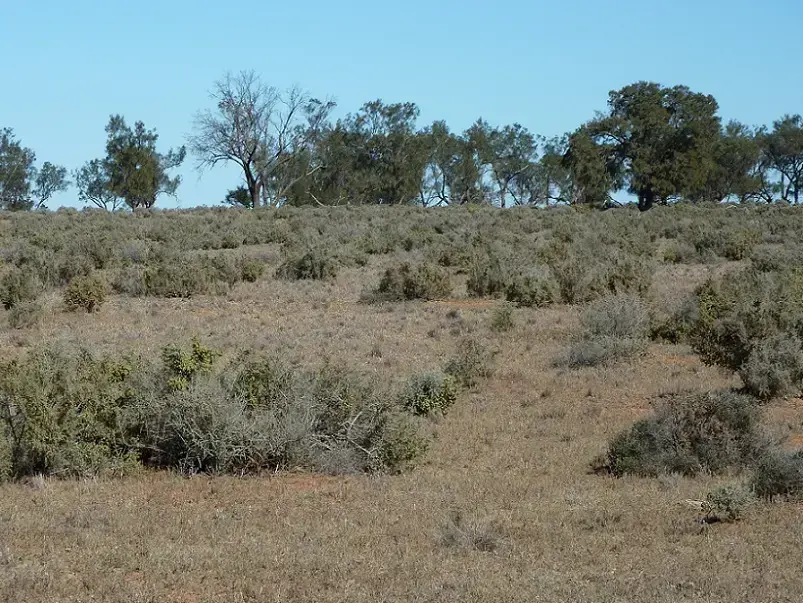
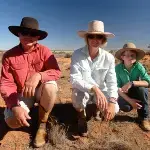 Meet Angus and Kelly Whyte from Wyndham Station
Meet Angus and Kelly Whyte from Wyndham Station